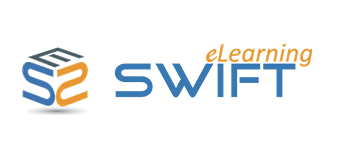What is Microlearning: A Complete Guide For Beginners
If you are looking for the ideal training solution to boost engagement and knowledge retention then, microlearning is the best learning solution.
Today’s learners insist on complete control over their learning, including what they learn, how they learn, and when they learn. As a result, the time is up for preferred learning experiences that support effective learning in a corporate environment.
Microlearning is the best way out! Microlearning has grown in popularity as an adept solution for bite-sized training modules that are more engaging, less time-consuming, and cost-effective.
In fact, microlearning has stemmed out of eLearning strategies to suit the needs of the present day learners.
Swift eLearning Services, a leading eLearning provider with over a decade of experience, provides highly engaging, quality-oriented microlearning modules to address all of your eLearning needs. For further insights, call us for a demo.
In this blog, we’ll learn about microlearning in detail, along with its benefits.
Let’s get started!
What Is Microlearning?
Microlearning is a learning strategy that consists of small learning units or short-term learning activities that are designed to create holistic learning experiences. It’s a specialized form of eLearning that provides learners with micro-modules to study at their own pace.
Microlearning, without a doubt, is always brief, but it can take many forms, ranging from simple text to full-fledged interactive multimedia, to simplify complex learning strategies in the simplest way possible.
Microlearning is the easiest and convenient way of learning that improves learning quality and performance. It can usually be accessed on-demand and can be completed quickly by learners while they are at work.
Microlearning is a perfect training model and an effective solution for learners who need to meet their learning and training needs within today’s conflicting schedules.
Examples of Microlearning
Some of the microlearning examples include:
- Microlearning videos (Brief and interactive videos, Whiteboard animations, etc.)
- Games (Simulations, Polls, Flashcards, etc.)
- Short snippets of audio (Micro-lectures, etc.)
- Infographics (Statistical, Hierarchical, Comparison infographics)
Benefits of Microlearning
As mentioned, microlearning contains brief bursts of information, making corporate learners more engaged, less distracted, and highly attentive. It helps learners to complete the module or activity within a short span of time, compared to traditional online training sessions.
It has significantly become an important part of effective learning and training resources that are easier to digest and remember.
Here are the notable benefits of microlearning that corporate learners can enjoy to stay ahead of the learning curve.
Fast Development – Faster Reach
Microlearning modules are simpler to create, and implement than traditional learning modules. It meets an organization’s needs by training corporate learners in a quicker way, in the most comfortable environment possible.
This is probably the most significant benefit for learners that microlearning modules are available on-demand with bite-sized information/nuggets. With microlearning, you can create courses faster allowing to meet changing business goals and ongoing training demands.
Increased Learner Engagement
When compared to the “serious study” feel of traditional eLearning training, learners can reap the full benefits of limited attention spans, overcoming boredom and reducing distractions with microlearning.
Microlearning is the most engaging type of online training because it provides learners with real-world value in a timely and convenient manner. As a result of their increased engagement and motivation, they are better able to troubleshoot problems, overcome obstacles, and broaden their knowledge.
Boosts Learning Retention
As microlearning courses are designed to address a single learning objective, they reduce cognitive overload and improve knowledge and learning retention. Hence learners are more likely to remember what they’ve learnt and to understand what actions need to be taken or what learning outcomes need to be achieved.
Moreover, microlearning overcomes the “forgetting curve” by enhancing knowledge retention through short games, quizzes, and videos.
Gives learners a positive learning culture
A positive learning culture encourages job-related knowledge and skill development while increasing learner engagement, motivation, and satisfaction.
Microlearning is a great way to foster a positive and supportive learning culture because the micro-modules take less time and effort to understand, and retain for a longer period of time. Furthermore, these courses are on-demand and easy to share, making learning efficiency highly accessible, effective, and qualitative.
Conclusion
Microlearning is undoubtedly a smart learning strategy that encourages learners to learn quickly while allowing content developers to create effective and engaging content, resulting in successful outcomes.
Microlearning isn’t just a fad in eLearning; it can also be used to build an effective learning culture while staying within a company’s profitability and revenue goals.
If you want to use microlearning to increase learner engagement, motivation, and knowledge retention in order to rule the digital world, check out our real-world microlearning videos, games, and short learning interactivities.
With more than a decade experience, Swift eLearning Services is a leading trend setter in providing eLearning solutions, including custom elearning, rapid elearning, powerpoint to elearning and microlearning solutions.
For any queries, you can contact us.
Related FAQs
What is microlearning?
Microlearning refers to a learning approach that delivers small, bite-sized content in short and focused bursts. It typically includes concise modules or lessons that are easily digestible and can be consumed in a short amount of time.
What are the benefits of microlearning?
Microlearning offers several benefits, including increased learner engagement, improved knowledge retention, flexibility in learning, accessibility across devices, targeted and personalized learning experiences, and the ability to reinforce learning through repetition.
What types of content are suitable for microlearning?
Microlearning is versatile and can accommodate various types of content. It is commonly used for delivering quick tutorials, skill-based training, product demonstrations, quizzes or assessments, performance support materials, and just-in-time learning resources.
How long should microlearning modules be?
Microlearning modules are typically designed to be short and focused, ranging from a few minutes to around ten minutes in duration. The emphasis is on delivering concise and specific information that can be easily consumed and applied.



Leave a Reply
Want to join the discussion?Feel free to contribute!